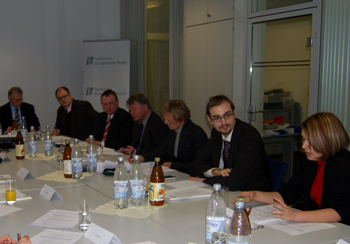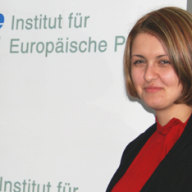Expert Workshop: ESDP missions — Evaluating the past, addressing the future

Am 15. Januar 2010 veranstaltete das IEP einen Expertenworkshop zum Thema „ESDP missions: Evaluating the past, addressing the future“. Die Veranstaltung, an der Experten aus Politik und Wissenschaft teilnahmen, fand im Rahmen des Study Programme on European Security (SPES) statt.
EU member states in the driver’s seat? Setting up ESDP missions before and after the Lisbon Treaty
The first presentation was given by Dr des. Nadia Klein, research associate at the University of Cologne. Even though the new ESDP working structures are still in the making, she presented some ideas about the future conditions for setting up ESDP missions, and compared its four main stages — agenda setting, planning, decision-making and implementation — before and after the Lisbon Treaty was ratified. The primary focus of Klein’s presentation was the question ‘who is sitting in the driver’s seat?’. She refuted the argument that before the Lisbon Treaty ESDP was an exclusive domain of the EU member states and at the same time contradicted the common belief that under the Lisbon Treaty the member states lose control in the field of ESDP.
Concerning the first stage — agenda setting — Klein stated that under the Lisbon Treaty the European Commission will be institutionally more connected to the field of foreign and security policy through the double-hatted High Representative (HR), and thus, single member states’ possibilities to determine the selection of ESDP missions will be reduced. In contrast, the intergovernmental character of EU crisis management will be reinforced in the planning phase. In the framework of the External Action Service, national diplomats are expected to be sent to leading positions, which was not the case in the respective planning structure under the Treaty of Nice. As far as the third stage — decision-making — is concerned, there has not been much change compared to the Nice Treaty: unanimity remains the rule. Finally, regarding the implementation phase, Klein distinguished two trends. On the one hand, the small CFSP budget has been significantly increased over the past years; on the other hand, however, the member states will continue to cover most of the costs arising from crisis management missions, and what is more, a new start-up fund will be created outside the EU budget, i.e. beyond the control of the European Parliament.
Klein concluded that the changes in setting up ESDP missions under the Lisbon Treaty have not been substantial: The EU member states still occupy the driver’s seat; however, the double-hattet HR will also have a front seat and will not hesitate to grab the steering-wheel from time to time.
Evaluating the outcome of ESDP civilian missions: What role for local ownership?
Elena Stavrevska, SPES fellow, presented the subject from a different perspective, namely that of the outcome sustainability of ESDP civilian missions. She stated that the evaluation of such a mission requires the introduction of a yardstick according to which the mission sustainability could be measured. During her fieldwork in the Western Balkans Stavrevska discovered a relationship between the involvement of local authorities in the planning process of the necessary reforms and their sustainability. She singled out three kinds of reforms that have been introduced in her case-studies (EUPOL Proxima in Macedonia (2003- 2005) and EUPM I in Bosnia and Herzegovina (2003–2005): the one-off reforms, whose effects are still present in both of the countries, the reforms continued by another ESDP mandate or taken over by another organization (also still in place), and the reforms left to the local authorities to decide upon their continuation. In the latter case, most of the reforms in Macedonia are still present, whereas in Bosnia and Herzegovina results vary across entities and cantons. The discrepancy between the two countries in the sustainability of the latter type of reforms, is what Stavrevska tries to explain in her SPES project. According to her, the level of local involvement in shaping, not merely the implementation, of the reforms, is what has a deciding effect on their sustainability. Furthermore, whether the reforms are kept in place also depends on the capacity of the host country. Thus, taking into consideration the context of the host country prior to the ESDP mission deployment, the mission outcomes and the overall situation in the two countries can be seen as different stages of the same stabilization process.
Towards a holistic approach of ESDP? Assessing the integration of civil and military means in EU crisis management
Dr Marco Overhaus, researcher at the German Institute for International and Security Affairs (SWP), presented another aspect of ESDP missions, i.e. that of civil-military collaboration. While it is obvious that in some cases civil-military cooperation is necessary, the frequency of its occurrence has been less than satisfactory. According to Overhaus, the assessment of a successful civil-military mission is based on context-dependent, but rather general criteria. They include, for instance, the existence of an overarching political context in which civil and military actions are embedded, non-contradictory operation mandates and appropriate institutions, increased local ownership, as well as a positive impact on conflict resolution. In the context of the above mentioned indicators, Overhaus found the civil-military collaboration to be limited in both of his case studies — Bosnia and Herzegovina and the Democratic Republic of Congo, having only single examples of success.
One of the underlying reasons was the spread of resource problems, i.e. the spread of the very limited resources over a very large area and numerous missions. According to Overhaus, there was little planning at the European level; on the other hand, however, where civil-military cooperation was achieved, it was despite this lack of an efficient strategy. Moreover, civil-military cooperation contributed only marginally to local ownership. Last but not least, Overhaus stated that there is only a very weak link between ESDP military instruments and the overarching political strategies. Despite EU’s ambition to become a unique security actor through its ability to combine civilian, economic and military means in crisis management and post-conflict reconstruction, there is a considerable gap between these ambitions and real capabilities. As Overhaus stated, there are often no targeted military programmes, and military activities are in most cases not complemented by political and economic planning. He concluded that institutional reforms are likely to improve civil-military cooperation and produce better outcomes of joint missions. However, more important problems, such as the disconnection of the European Commission from military activities, cannot be fixed by institutional reforms, as they are rather of political nature.
On the ground – evaluating practical work from a first hand experience
Klaus Wolf, Senior Chief Inspector, Division B 4, Civilian Crisis Management, International Police Missions, Federal Ministry of the Interior, summarised the statements of the above speakers and highlighted practical problems the German police and their European partners encounter while fulfilling the mandate of an ESDP civilian mission. As he put it, one major problem for all EU member states is the recruitment of personnel given the difficulty of taking policemen off their function in their home country. According to Wolf, only two or three EU member states, including Germany, have reacted to this challenge by stipulating the number of policemen designated to participate in ESDP missions in the organisational charts of their national police. Touching upon the previous statement, Wolf emphasized practical issues with civil-military collaboration. In his opinion, the professional mentality of civil and military staff differs due to distinct needs. The knowledge of their respective methods is by all means helpful and can certainly optimize achievements of objectives. As regards Stavrevska’s presentation, he agreed that local ownership matters and that a sustainable approach needs a well balanced mix of European wishes and local needs.
Rainer Kühn, former Head of EULEX Police Component, Kosovo, stressed positively the recruitment policy in the framework of ESDP. Given different selection procedures, the quality of personnel in ESDP missions is generally higher than in UN missions. While the UN asks for contingents and assigns the specific jobs at a later date, ESDP advertises concrete jobs and chooses its personnel according to the respective job descriptions.

